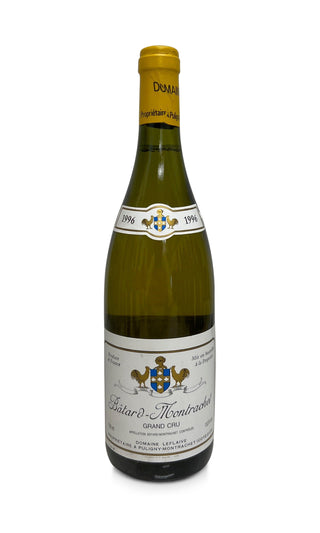Parker about Bâtard-Montrachet Grand Cru 1996
1996 is particularly successful for Batard-Montrachet. Leflaive's explodes from the glass with highly-expressive mineral, hazelnut and toasty oak aromas. On the palate, this full-bodied, silky and awesomely rich wine has highly-delineated yet fat and layered waves of white fruits, stones and spices. Brawny yet feminine, powerful yet elegant, this gem is a tour de force!
Description
| Land | France |
| Region | Burgundy |
| Rebsorten | Chardonnay 100% |
| Alkoholgehalt | 13.50% |
| Füllstand | Into Neck |
| Verschlußart | cork stopper |
| Kennzeichnung | Contains sulphites |
| Farbe | White |
| Inverkehrbringer | Domaine Leflaive Place des Marronniers FR 21190 PULIGNY-MONTRACHET |
| Charakter | Dry |
| Servierempfehlung | Decant at 10-12°C |
| Trinkempfehlung | 2006 - 2035 |
| Parker Punkte | 97 |
| Jahrgang | 1996 |
Burgundy, France 🇫🇷
Goes well with

Bâtard-Montrachet Grand Cru 1996

The Domaine Leflaive Bâtard-Montrachet Grand Cru 1996 is an exceptional white wine from the renowned Burgundy wine region of France. It is made from 100% Chardonnay grapes and comes from the Bâtard-Montrachet Grand Cru vineyard, known for its premium Chardonnay wines. The wine has a light, golden yellow color and exudes an intense, complex bouquet of aromas reminiscent of white flowers, citrus fruits, and exotic fruits like pineapple. Added to this are notes of hazelnut, brioche, and toast, which come from aging in oak barrels. On the palate, the wine is full-bodied and complex, with a rich texture and a perfect balance of fruit and acidity. The aromas of citrus and exotic fruits are complemented by nuances of spice and minerals. The finish is long and elegant, reminiscent of almonds and brioche.
Domaine Leflaive
Information about the winemaker:
Domaine Leflaive is one of the most famous wineries in Burgundy. The history of the domaine can be traced back centuries, but Joseph Leflaive is said to be the actual founder of today's winery. Shortly after the end of the First World War, he had to cope with the bankruptcy of his steelworks and decided to return to his homeland in Burgundy in order to continue the winemaking tradition of his ancestors and to expand his winery.
Learn more








